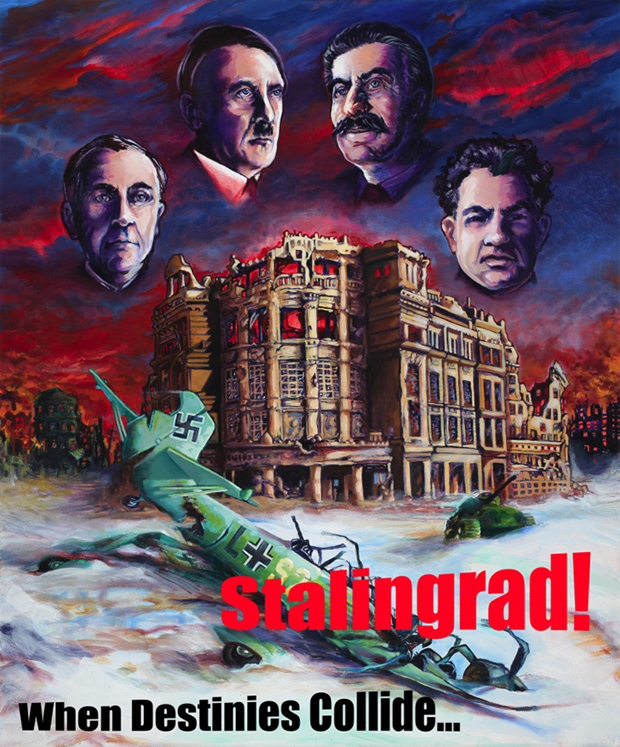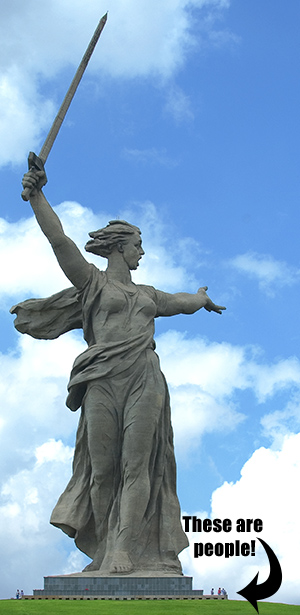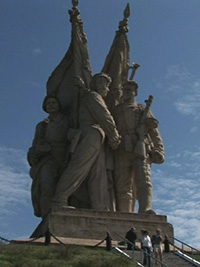
The German Sixth Army was lost at Stalingrad because Hitler refused to listen to his Generals.
Most historians believe that was the beginning of the end for the German war effort.
 |
Motherland Calling.In the modern day city of Volgograd, |
The Sixth Army was doomed
when Hitler asked Luftwaffe Commander, Hermann Goering, if the 300,000
man army could be supplied by air.
Goering, wanting to impress Hitler
(trying to make up for his failure to protect
German cities from being bombed),
said 'yes, it can be done'.
Goering then told some
subordinates to take care of it, and then he left for a shopping trip in Paris!
By the way, the British Secret Service
thought Goering was a pompous buffoon.
August, September and October, 1942
The entire city of Stalingrad has been destroyed. The German air force drops many thousands of bombs.
It has been estimated that an average of 4000 bombs fell on every square kilometer (.6 mile).
The entire city burns.
The Sixth Army invades the city.
The battle for Stalingrad is a nightmare, for both sides.
Desperate men and women viciously fight for
every square foot of the city.
They fight in the bombed and burned buildings; they fight in the sewers.
The tallest hill, Mamaev Kurgan, (where the Motherland Monument now stands),
is inundated with soldiers
and explosions.
Possession of it changes a number of times.
Russian General Vasily Chuikov throws away the book on how to fight battles.
He instructs his men to stay
as close to the German lines as possible;
this prevents the Germans from using their air force and artillery,
for fear of hitting their own soldiers.
Hitler is angry that the city hasn't been taken. Sixth Army Commander Paulus is frustrated.
The Luftwaffe continues to bomb the city and the factory district.
German officers are privately complaining
that Hitler has become obsessed with Stalingrad.
"He wants to make piles of rubble into bigger piles of rubble."
November, 1942
Stalin and his Generals devise the plan that would begin
the downfall of the German army in Russia,
and indeed, would help win the war.
The plan was to surround the Sixth Army and destroy it.
Tanks, planes and soldiers would be sent to the Stalingrad front, but would not be done openly.
Troops and weapons would
be moved at night, and camouflaged during the daytime.
This really didn't fool the Germans. They were constantly patrolling the air and taking photos.
A top German officer
briefed General Friedrich Paulus and his top officers.
"We have photos and intelligence that the Russians are
planning a major counter offensive.
This is an attack army; armed to the teeth."
The German officer is stunned when Paulus seems somewhat unconcerned.
An interesting note.
The sniper battle between Ace Russian sniper Vassili Zaitsev and
a top German sniper... was Russian propaganda.
It's a great story, but not true.
November 19, 1942
At 6:30 AM thirty-five hundred Russian guns began firing.
The Rumanian Third Army (a puppet army
protecting the flanks of the Sixth Army), is destroyed.
The Germans are stunned to find Russian tanks among them.
From that point forward, the German army was now fighting for its life.
November 23, 1942

The Russians complete their encirclement of the Sixth Army.
About fifty miles from modern day Volgograd,
there is a huge monument at the area called Kalach.
This was the first point to report a linkup with other soldiers.
We've all seen the film clips of Russian soldiers running through the snow,
meeting with their compatriots
and hugging.
Most people don't know that the linkup came sooner than the Russians expected;
the scenes of
hugging soldiers were reenacted days later for the 16MM cameras.
December, 1942
The airlift has completely failed.
Never did the German air force succeed in delivering the absolute minimum
requirement of 300 tons every day.
It wasn't that they didn't try. Over a five week period,
300 transports were shot down.
A relief army, led by the very well respected General Erich Von Mannstein, failed.
The Sixth Army was doomed.
The extremely cold winter (the Volga River froze, which rarely happens), had decimated the Germans.
German soldiers
were freezing and starving to death.
On Christmas Day, even though there was a one day truce, 1280 German soldiers died.
At the end of December, German soldiers were killing themselves.
January, 1943
The final German airfield was lost. During the last week of January,
General Paulus gave it all up
and moved his command post to the basement of the bombed and
burned out Univermag department store.
There were now more than one-hundred thousand German soldiers in the basements of Stalingrad.
These were the ones that chose not to kill themselves.
On January 30th, Hitler promoted Paulus to Field Marshal, because no Field Marshal had ever
surrendered.
The idea was that Paulus would do his duty and kill himself.
The very next day, Paulus surrendered.
Friedrich Paulus was taken to a farmhouse for the official surrender.
He received promises
that his soldiers would be treated well.
However, this was a bad war and it never happened.
Of the more than 105,000 Germans taken into captivity,
less than five thousand survived to return
home to Germany, many years later.
In his memoirs, Nikita Khrushchev wrote what had never before
been admitted,
that many of the German prisoners had been executed by their Russian guards.
We've all see film of the long lines of German soldiers being led off to captivity.
However, many
of them remained in Stalingrad to help repair the damage.
In March, an outbreak of typhus killed
most of them.
South of the city, the Russians dug a big trench and dumped forty thousand German bodies into it.
But things were not better for the half million other German, Italian, Hungarian and Rumanian
prisoners.
During the months of February, March and April, more than four hundred thousand of them died.
Friedrich Paulus and his top officers were taken to Moscow, where they survived the war in
relative comfort.
For the rest of his life, he would defend his actions at Stalingrad.
Adolph Hitler would later admit that he, himself,
bore the ultimate blame for the destruction
and loss of the Sixth Army.
Hitler had failed to listen to his top officers.
After Stalingrad, most of the attempts on Hitler's life began.
Winston Churchill later wrote that
the Russians at Stalingrad tore the guts
out of the German war machine.
At least 750,000 Russians (possibly as many as a million), died in the battle.
In conclusion, it doesn't matter that this battle took place seventy years ago.
It doesn't matter that it changed the course of World War II.
What does matter is that so many people died... died in a battle... for one city.
Fletcher Christian was not a hero...
Mutiny on the Bounty
The true story.
Amazon
His aviation successes, Vegas casinos,
his power, his downfall... and his women.
Howard Hughes and the Stars of Hollywood
Home Page
History and Mysteries
November 23, 1942
